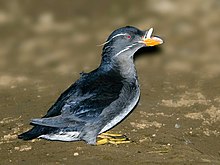| Rhinoceros auklet | |
|---|---|

| |
| Adult, Japan | |
| Scientific classification | |
| Domain: | Eukaryota |
| Kingdom: | Animalia |
| Phylum: | Chordata |
| Class: | Aves |
| Order: | Charadriiformes |
| Family: | Alcidae |
| Genus: | Cerorhinca |
| Species: | C. monocerata
|
| Binomial name | |
| Cerorhinca monocerata (Pallas, 1811)
| |

| |
The rhinoceros auklet (Cerorhinca monocerata) is a seabird and a close relative of the puffins. It is the only extant species of the genus Cerorhinca. Given its close relationship with the puffins, the common name rhinoceros puffin has been proposed for the species.[2]
It ranges widely across the North Pacific, feeding on small fish and nesting in colonies. Its name is derived from a horn-like extension of the beak (the anatomic term for this extension is the rhamphotheca). This horn is only present in breeding adults, and like the elaborate sheath on the bill of puffins is shed every year. This horn also possesses fluorescent properties, which is likely involved in reproductive signalling.[3]
The rhinoceros auklet (also known as the rhino auklet, horn-billed puffin, or unicorn puffin), is a medium-sized auk with a large, strong, orange/brown bill (with the 'horn' protruding from it). The plumage is dark on top and paler below; breeding adults (both male and female) possess white plumes above the eyes and behind the bill. Males are slightly larger than females (about 10% in mass).[citation needed]
- ^ BirdLife International (2018). "Cerorhinca monocerata". IUCN Red List of Threatened Species. 2018: e.T22694924A131933971. doi:10.2305/IUCN.UK.2018-2.RLTS.T22694924A131933971.en. Retrieved 12 November 2021.
- ^ AOU. (2008) AOU Committee on Classification and Nomenclature (North & Middle America) Proposals 2008-A Accessed 28 May 2008.
- ^ Wilkinson, B.P.; Johns, M.E.; Warzybok, P. (2019). "Fluorescent ornamentation in the Rhinoceros Auklet Cerorhinca monocerata". Ibis. 161 (3): 694–698. doi:10.1111/ibi.12715. S2CID 92406445.
